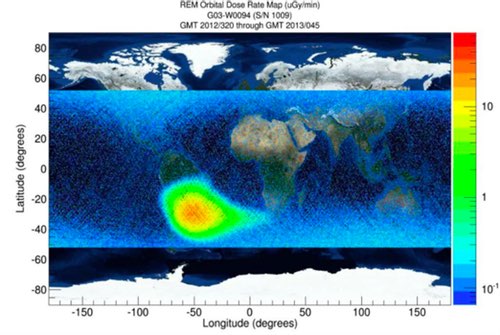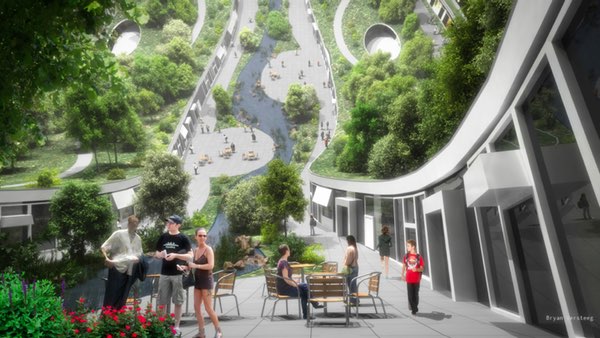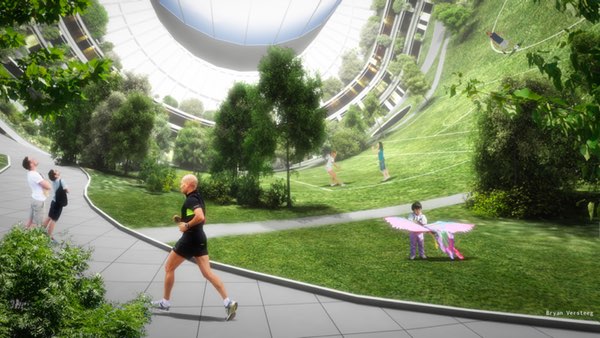A radically easier path to space settlementby Al Globus
|
| It is our incredibly good luck that there is a region of space, very close to Earth, where radiation levels are much, much lower than at the usual suspects. |
Locations for the usual space settlement suspects include the Moon, Mars, asteroids, and the Earth-Moon L5 point (or other high Earth orbit). They all suffer from one very serious problem: they are very far away, anywhere from 363,000 to 400,000,000 kilometers from Earth. This makes everything we want to do extremely difficult.
All space settlements need pressurized habitat, power systems, thermal control, communications, life support, materials recycling, and radiation shielding. As radiation levels in space are high compared with Earth, the mass of the radiation shielding completely dominates the mass of most space settlement designs because inadequate shielding can lead to cancer, cataracts, and sterility. In orbits beyond Earth’s magnetic field, radiation protection requires about seven tons of water, or eleven tons of lunar regolith, per square meter of hull and a couple of tons less on the surface of Mars or the Moon [Globus 2016]. This amounts to millions of tons of material for a settlement big enough that people might actually enjoy living in it, perhaps 100 meters across or more, once the excitement of living in space wears off. If the radiation shielding wasn’t needed, space settlement would be vastly easier.
 Figure 1. Radiation measurements taken on the ISS (International Space Station). Note the very low levels (blue) near the equator, which is on the horizontal line starting at 0 on the latitude scale. (credit: NASA) |
It is our incredibly good luck that there is a region of space, very close to Earth, where radiation levels are much, much lower than at the usual suspects. This is low Earth orbit (LEO) directly over the Equator (or ELEO), as illustrated above. The Earth’s magnetic field protects this region from all but a small fraction of space radiation, albeit the most energetic part. Radiation levels are so low that, below about 500 kilometers, it is possible, even likely, that no dedicated radiation shielding will be necessary [Globus 2016]. This means that a 100-meter-diameter cylindrical settlement in ELEO might have a mass of around 8.5 kilotons [Globus 2017a], hundreds of times less than what would be needed above the Earth’s magnetic field. This entire mass could be launched by about 160 SpaceXFalcon Heavy or 28 SpaceX Interplanetary Transport System launches [Globus 2017a]. This is not for a few capsules connected by tunnels, but an open living area comparable in size to a large cruise ship with zero-g recreation at the axis of rotation, full one-g pseudo-gravity just inside the hull, and recreational space walks.
 Figure 2. Artist concept of a small early space settlement. Note the curvature necessary to generate pseudo-gravity by rotation. (credit: Bryan Versteeg) |
One might object that to get Earth-normal pseudo-gravity with a 100-meter diameter you need to rotate a settlement at about four RPM (revolutions per minute), which will make many people sick. That is true, but it is also true that people adapt to rotation at four RPM within a few hours or days and are subsequently just fine [Globus 2017b]. If you were to move to Nepal you would be altitude sick for a few days, but Nepal is still a beautiful place to live.
You might also note that most Mars/Moon settlement schemes involve putting a module on the Martian/Lunar surface with far less than 28, much less 160, launches. But that’s for a module a few meters across, similar to vehicles that have been in LEO off and on since the 1960s and much smaller than the ISS, which has been continuously inhabited since 2000.
| Launch vehicle prices need to come down by a factor of perhaps 50. Absent a gigantic pile of government money, how can this been done? One word: tourism. |
For a given size, the total mass of the material needed from Earth for early ELEO versus Mars/Moon settlements is about the same. Low radiation levels in ELEO mean settlements there require little or no radiation shielding. Although radiation levels on the Martian/Lunar surface are high, about half that in free space, local materials can be used for radiation shielding. However, Mars/Moon residents will rarely leave their habitat due to the radiation, and LEO development will continue to be far ahead because LEO is at least 100,000 times closer than Mars and 720 times closer than the Moon, giving ELEO a massive logistical advantage in the early years of space settlement.
While space settlement may be vastly easier to get started in ELEO than anywhere else, it is still a huge task. Launch vehicle prices need to come down by a factor of perhaps 50 [Globus 2017a], reliable, nearly-closed large-scale life support must be developed, and a million other engineering problems must be solved so that people can live comfortably, safely, and enjoyably in space. Absent a gigantic pile of government money, how can this been done? One word: tourism.
Tourism can supply the two things essential to market-driven ELEO settlement development:
- A very high flight rate to make fully reusable launchers economically viable. We estimate at least 10,000 flights per year are needed, compared to less than 100 today.
- A market for ever-larger and more sophisticated space hotels, starting with the ISS.
Seven paying tourists have flown to the ISS (one twice) on a seven- to ten-day trip, but right now no seats are for sale. Rumor has it that the first few space tourists paid about $20 million and the most recent flight was on the market for $50 million. While this is discouraging (the price is absurdly high and headed in the wrong direction) surveys suggest that if someone could drop the price a bit, much larger numbers of people would want to go [Crouch 2001].
The good news is that two US human-rated vehicles are in late-stage development under NASA contracts that can reasonably be expected to launch tourists into orbit for around $20–30 million per seat, perhaps less. If this is successful and makes a profit, flight rates will increase and, as more flights are booked, economies of scale can reduce the price, which in turn increases the size of the market, which enables a reduction in price, which increases the size of the market, and so on. We need to get on this virtuous spiral of dropping costs leading to bigger markets leading to lower cost. If the cost is low enough, the market is measured in hundreds of thousands or even millions of customers per year [Globus 2017a], which is the sort of market needed for the kind of low-cost, high-cadence transportation system necessary to settle space regardless of destination.
| If the cost is low enough, the market is measured in hundreds of thousands or even millions of customers per year, which is the sort of market needed for the kind of low-cost, high-cadence transportation system necessary to settle space regardless of destination. |
There is also a system in the early stages of development that is projected to drop launch prices by about the amount needed for affordable ELEO settlement. SpaceX’s Interplanetary Transportation System (ITS) is a two-leg Earth-to-Mars transportation system based on large fully reusable vehicles [Musk 2016]. Target costs are $140 per kilogram and $200,000 per passenger to Mars. The first leg of the ITS is Earth to LEO, snd just going to LEO should be significantly cheaper than all the way to Mars: half or less. This is sufficient to make transport of settlers and materials to ELEO not much more than $1 million per settler. Almost all of that cost is for materials, which could be recovered by selling one’s place on a settlement and returning to Earth.
The ITS will use the Raptor rocket engine, which will also be used on the Falcon 9 and Falcon Heavy. This engine is currently in the late stages of development and a large carbon composite cryogenic fuel tank has been fabricated and is undergoing test. The ITS is no mere paper study.
For the ITS to hit the target cost will require many launches for economies of scale. As mentioned above, at the right price the space tourism market is measured in hundreds of thousands, even millions of trips a year. All those tourists need somewhere to go, meaning they will need space hotels. The first ones may be small to keep upfront costs down, but if space tourism is successful, the desire for bigger, more sophisticated, and more comfortable hotels could drive constant improvement.
As luck would have it, most of what is needed for ELEO settlements is also important for hotels: recycled air and water, food, power systems, communications with Earth, and so on. Hotels may even want artificial gravity, achieved by rotation, so that guests need not learn how to use a zero-g toilet, which is difficult. Also, staff can have longer tours of duty, reducing transportation costs, as their bodies will not be continuously subject to weightlessness that can cause a number of problems [Globus 2017b]. Once hotels have developed, most of the necessary technology and supporting infrastructure for building the first space settlement should be not much more difficult than building another hotel.
The first settlement in ELEO might look something like Kalpana Two:
In an Internet survey of space enthusiasts, 30 percent of respondents said they would very much like to live in something like Kalpana Two in ELEO, including raising their children. Six percent said they were very interested in living in a habitat:
- no bigger than a large cruise ship
- with no more than about 500 people
- and that cost 75 percent of their wealth and lifetime income.
That’s enough to get space settlement started.
Although building Kalpana Two after a few decades of space tourism development may be much easier than starting from scratch, it is still a monumental effort requiring a great deal of money and those funds will be easier to raise if Kaplana Two and later settlements have a mass-market product to sell to Earth.
| The first ELEO settlement is the hardest to build. The second and subsequent ones will be easier because lessons will be learned and infrastructure developed. |
Kalpana Two residents could assemble and test extremely large communication satellites, much larger than those launched today. Large comsats are attractive because the larger the spacecraft antenna and the larger its power-producing solar arrays, the smaller the antenna on the ground must be and the less battery power is needed, two things for which there is a large and growing market. ELEO is also a good place to manufacture ultra-light solar sails, as the sails need not be folded into a fairing, launched, and unfolded. While the market for solar sails is small, if you cover one side of the sail with power-producing electronics you have extremely light power arrays that can be used for large comsats. Put fiber lasers on the other side of the sail and you can beam power [Globus 2010], first for in-space applications such as power for Kalpana Two, and later to deliver power to Earth—a gigantic market.
The first ELEO settlement is the hardest to build. The second and subsequent ones will be easier because lessons will be learned and infrastructure developed. It’s estimated that there is room for at least a few million people spread out in a few hundred settlements in ELEO [Globus 2017a]. This can provide the key requirement for commercially viable lunar and asteroid mining: a decent-sized market in space. It is hard for extraterrestrial materials to compete on Earth due to transportation costs. However, in space, lunar and asteroidal materials have the edge due to launch costs from Earth. The problem today is that the in-space market is a single satellite designed for in-space refurbishment (the Hubble Space Telescope) and six people on the ISS, which is tiny. Equatorial LEO settlement is a game-changer for lunar and asteroidal mining.
Once the mining infrastructure to deliver substantial materials to equatorial LEO is in operation and ELEO fills up with settlements, it will be time for the next step: settlements in orbit beyond the Earth’s protective magnetic field. These settlements will require millions of tons of radiation shielding, which can provide a market for a huge expansion of lunar and asteroidal mining. This, in turn, can provide economic support for mining settlements on the Moon. The next step is settlements co-orbiting with near Earth asteroids. This network of settlements can then expand to Mars and the asteroid belt. Of course, for Mars and the Moon the problems associated with raising children in partial-g—including but not limited to growing up with weak muscles and bones—will have to be addressed.
At this point we will be well on our way to turning the resources of this solar system into living, breathing settlements in huge numbers. The next step, of course, is to send groups of settlements to Proxima Centauri and start the billion-year project of greening our galaxy. After all, if you have lived for 50 generations in free-space settlements, does it matter much if you are close to Sol or on the way to the nearest star? Probably not, at least for some, but that is a task for future generations. For now, our mission, should we choose to accept it, is to get space tourism on track to develop the technology and infrastructure necessary to build something like Kalpana Two in equatorial LEO.
References
[Crouch 2001] Crouch, G. I., “Researching the Space Tourism Market,” presented at the annual Conference of the Travel and Tourism Research Association, June 2001.
[Globus 2017a] Globus, Al, Stephen Covey, and Daniel Faber. “Space Settlement: An Easier Way,” February 2017.
[Globus 2017b] “Space Settlement Population Rotation Tolerance,” Al Globus and Theodore Hall, preprint, January 2017. This contains data and references for human response to rotation claims in this article.
[Globus 2016] “Orbital Space Settlement Radiation Shielding,” Al Globus and Joe Strout, preprint, December 2016. This contains data and references for radiation-related claims in this article.
[Globus 2010] “Towards an Early Profitable PowerSat,” Al Globus, Space Manufacturing 14: Critical Technologies for Space Settlement, NASA Ames Research Center, Mountain View, CA, October 29–31, 2010.
[Musk 2016] Presentation by Elon Musk at the International Astronautical Congress in Guadalajara, Mexico September 26-30, 2016. Accessed October 2016
